Economy
Good Morning Nigeria: Lower Current-Account Surplus Due to MCP

By FBNQuest Research
The balance of payments for Q2 2017 shows that the current-account surplus narrowed from the equivalent of 3.2% of GDP to 1.6%.
The explanation lies in a decline in the trade surplus from 2.7% to 2.4% of GDP, along with a larger widening of the services outflow from 2.4% to 3.8%.
Forex availability has been enhanced by the CBN’s multiple currency practices (MCP). Importers have benefited, which is evident from manufacturing PMIs, and retail has also been able to meet its requirements. In a forthcoming daily note we will examine trends on the capital account.
The share of oil and gas exports in GDP crashed from 25.0% in Q1 2012 to just 9.6% in Q4 2016. A modest recovery to 10.9% in both Q1 and Q2 is attributable to a pick-up in oil production and the contraction in GDP.
Merchandise imports increased by US$1.0bn q/q in Q2: if we strip out oil and gas, the increase rises to US$1.3bn. This underpins our point about fx availability and masks any benefits from the FGN’s import substitution policies.
The same is self-evident when we drill down into the outflow on services in Q2 2017. The debits on travel and other business services rose by US$900m and US$400m q/q respectively. Fx ix available at the CBN’s various windows if the user is comfortable with the price.
Net current transfers, which are overwhelmingly workers’ remittances, have held up better than expected, at more than 5% of GDP for four successive quarters.
We are comfortable with the smaller surplus on the current-account because offshore investors have returned to local equity and debt markets, and because the FGN is to revisit the Eurobond market this quarter.
Economy
Yuletide: Rite Foods Reiterates Commitment to Quality, Innovation

By Adedapo Adesanya
Nigerian food and beverage company, Rite Foods Limited, has extended warm Yuletide greetings to Nigerians as families and communities worldwide come together to celebrate the Christmas season and usher in a new year filled with hope and renewed possibilities.
In a statement, Rite Foods encouraged consumers to savour these special occasions with its wide range of quality brands, including the 13 variants of Bigi Carbonated Soft Drinks, premium Bigi Table Water, Sosa Fruit Drink in its refreshing flavours, the Fearless Energy Drink, and its tasty sausage rolls — all produced in a world-class facility with modern technology and global best practices.
Speaking on the season, the Managing Director of Rite Foods Limited, Mr Seleem Adegunwa, said the company remains deeply committed to enriching the lives of consumers beyond refreshment. According to him, the Yuletide period underscores the values of generosity, unity, and gratitude, which resonate strongly with the company’s philosophy.
“Christmas is a season that reminds us of the importance of giving, togetherness, and gratitude. At Rite Foods, we are thankful for the continued trust of Nigerians in our brands. This season strengthens our resolve to consistently deliver quality products that bring joy to everyday moments while contributing positively to society,” Mr Adegunwa stated.
He noted that the company’s steady progress in brand acceptance, operational excellence, and responsible business practices reflects a culture of continuous improvement, innovation, and responsiveness to consumer needs. These efforts, he said, have further strengthened Rite Foods’ position as a proudly Nigerian brand with growing relevance and impact across the country.
Mr Adegunwa reaffirmed that Rite Foods will continue to invest in research and development, efficient production processes, and initiatives that support communities, while maintaining quality standards across its product portfolio.
“As the year comes to a close, Rite Foods Limited wishes Nigerians a joyful Christmas celebration and a prosperous New Year filled with peace, progress, and shared success.”
Economy
Naira Appreciates to N1,443/$1 at Official FX Market

By Adedapo Adesanya
The Naira closed the pre-Christmas trading day positive after it gained N6.61 or 0.46 per cent against the US Dollar in the Nigerian Autonomous Foreign Exchange Market (NAFEM) on Wednesday, December 24, trading at N1,443.38/$1 compared with the previous day’s N1,449.99/$1.
Equally, the Naira appreciated against the Pound Sterling in the same market segment by N1.30 to close at N1,949.57/£1 versus Tuesday’s closing price of N1,956.03/£1 and gained N2.94 on the Euro to finish at N1,701.31/€1 compared with the preceding day’s N1,707.65/€1.
At the parallel market, the local currency maintained stability against the greenback yesterday at N1,485/$1 and also traded flat at the GTBank forex counter at N1,465/$1.
Further support came as the Central Bank of Nigeria (CBN) funded international payments with additional $150 million sales to banks and authorised dealers at the official window.
This helped eased pressure on the local currency, reflecting a steep increase in imports. Market participants saw a sequence of exchange rate swings amidst limited FX inflows.
Last week, the apex bank led the pack in terms of FX supply into the market as total inflows fell by about 50 per cent week on week from $1.46 billion in the previous week.
Foreign portfolio investors’ inflows ranked behind exporters and the CBN supply, but there was support from non-bank corporate Dollar volume.
As for the cryptocurrency market, it witnessed a slight recovery as tokens struggled to attract either risk-on enthusiasm or defensive flows.
The inertia follows a sharp reversal earlier in the quarter. A heavy selloff in October pulled Bitcoin and other coins down from record levels, leaving BTC roughly down by 30 per cent since that period and on track for its weakest quarterly performance since the second quarter of 2022. But on Wednesday, its value went up by 0.9 per cent to $87,727.35.
Further, Ripple (XRP) appreciated by 1.7 per cent to $1.87, Cardano (ADA) expanded by 1.2 per cent to $0.3602, Dogecoin (DOGE) grew by 1.1 per cent to $0.1282, Litecoin (LTC) also increased by 1.1 per cent to $76.57, Solana (SOL) soared by 1.0 per cent to $122.31, Binance Coin (BNB) rose by 0.6 per cent to $842.37, and Ethereum (ETH) added 0.3 per cent to finish at $2,938.83, while the US Dollar Tether (USDT) and the US Dollar Coin (USDC) remained unchanged at $1.00 each.
Economy
Oil Market Down Amid US Data, Geopolitical Tensions

By Adedapo Adesanya
The oil market settled lower on Wednesday as investors weighed US economic growth and assessed the risk of supply disruptions from Venezuela and Russia.
Brent crude futures depleted by 14 cents or 0.2 per cent to close at $62.24 a barrel and the US West Texas Intermediate (WTI) crude futures declined by 3 cents or 0.05 per cent to $58.29 per barrel.
US data showed the world’s largest economy grew at its fastest pace in two years in the third quarter, fueled by robust consumer spending and a sharp rebound in exports.
The stronger-than-expected increase in gross domestic product last quarter, which was reported by the Commerce Department on Tuesday, showed gross domestic product (GDP) increased at a 4.3 per cent annualized rate last quarter, the fastest pace since the third quarter of 2023.
Still, Brent and WTI prices are on track to drop about 16 per cent and 18 per cent, respectively, this year, their steepest declines since 2020 when the COVID pandemic hit oil demand, as supply is expected to outpace demand next year.
On the supply side, disruptions to Venezuelan exports have been the most significant factor pushing up oil prices, while market analysts noted that Russian and Ukrainian attacks on each other’s energy infrastructure have also supported the market.
Recently, Ukraine launched a drone strike on a Russian shadow fleet vessel in the Mediterranean. The country has been attacking Russian oil refineries throughout 2024 and 2025, but has visibly widened its campaign in recent weeks, striking oil rigs in the Caspian Sea and claiming credit for sea-drone attacks on three tankers in the Black Sea.
Russian President Vladimir Putin, who ordered a full-scale invasion of Ukraine in February 2022, has threatened to sever Ukraine’s access to the Black Sea in response to the attacks on tankers, which he regards as piracy.
In Venezuela, loaded vessels are waiting for new directions from their owners after the US seized the supertanker Skipper earlier this month and targeted two additional vessels over the weekend.
Reuters reported that oil shipments from Kazakhstan via the Caspian Pipeline Consortium are set to drop by a third in December to the lowest since October 2024 after a Ukrainian drone attack damaged facilities at the main CPC export terminal.
The American Petroleum Institute (API) estimated that crude oil inventories in the US saw a build of 2.4 million barrels in the week ending December 19. Crude oil inventories shrank by 9.3 million barrels in the week prior. The US Energy Information Administration (EIA) is due to release official inventory data on Monday, later than usual due to the Christmas holiday.
-

 Feature/OPED6 years ago
Feature/OPED6 years agoDavos was Different this year
-
Travel/Tourism9 years ago
Lagos Seals Western Lodge Hotel In Ikorodu
-

 Showbiz3 years ago
Showbiz3 years agoEstranged Lover Releases Videos of Empress Njamah Bathing
-

 Banking8 years ago
Banking8 years agoSort Codes of GTBank Branches in Nigeria
-

 Economy3 years ago
Economy3 years agoSubsidy Removal: CNG at N130 Per Litre Cheaper Than Petrol—IPMAN
-

 Banking3 years ago
Banking3 years agoFirst Bank Announces Planned Downtime
-

 Banking3 years ago
Banking3 years agoSort Codes of UBA Branches in Nigeria
-

 Sports3 years ago
Sports3 years agoHighest Paid Nigerian Footballer – How Much Do Nigerian Footballers Earn













